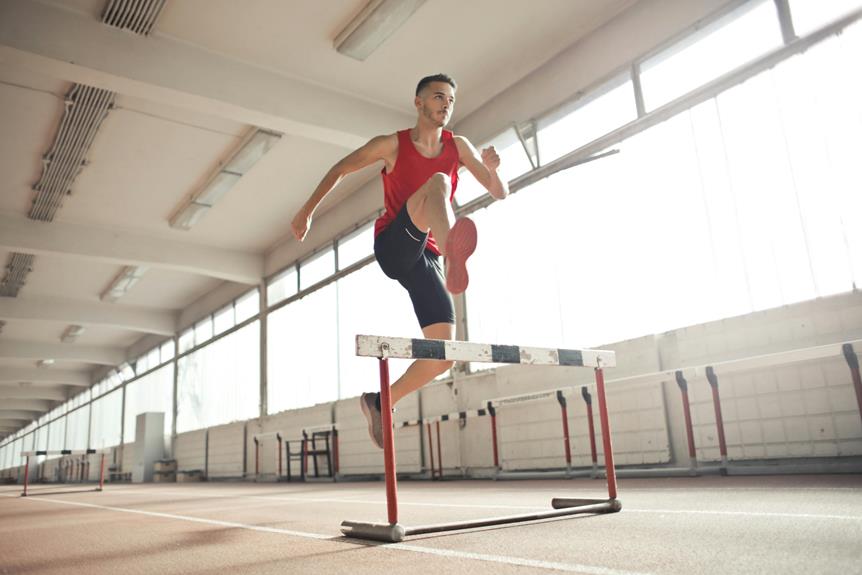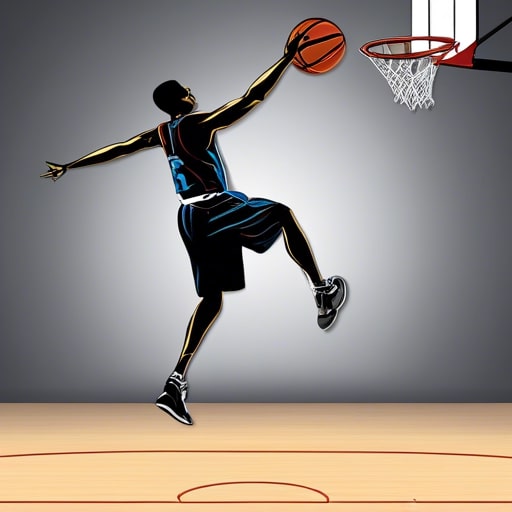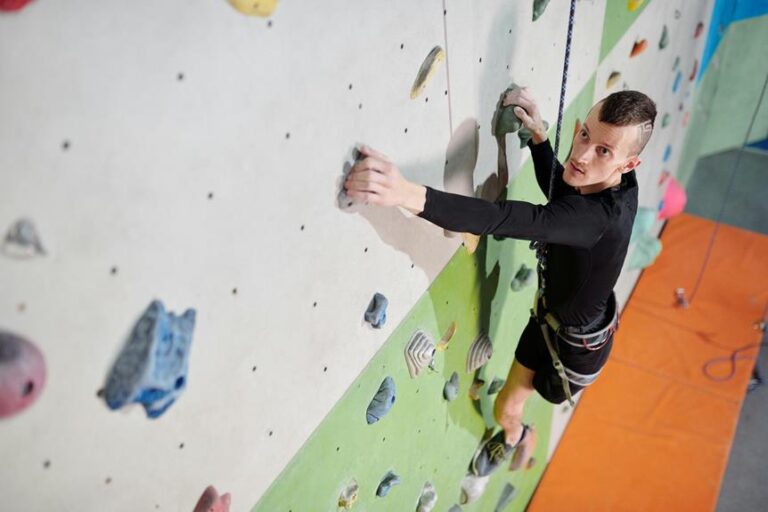Top Methods for Evaluating Jumping Power
To evaluate your jumping power effectively, utilize key methods like the Vertical Jump Test, which requires equipment such as a Vertec device, jump mat, measuring tape, chalk, and a wall. This test is vital for evaluating lower body power, offering insights into explosive strength and power.
Make sure to focus on achieving maximum height efficiently, employing an accurate measuring device to guarantee precise results.
Additionally, incorporating strength training through exercises like squats, deadlifts, and lunges, along with plyometrics like depth jumps and box jumps, can greatly enhance power output.
Remember, mastering these evaluation methods is crucial for improving your vertical leap potential.
Key Takeaways
- Utilize Vertical Jump Test for precise measurement of lower body power.
- Incorporate strength training to enhance muscle strength and power output.
- Implement plyometrics to improve explosiveness and power for jumps.
- Integrate Olympic lifts targeting fast-twitch fibers for explosive power.
- Evaluate joint mobility to optimize range of motion for increased power output.
Vertical Jump Test Essentials
To properly conduct the vertical jump test, gather essential equipment such as a Vertec device or jump mat, measuring tape, chalk, and a wall. The vertical jump test is a fundamental method for evaluating your lower body power.
By measuring how high you can jump, this test provides valuable insights into your vertical jump performance. It’s a key indicator of your explosive strength and power.
During the test, focus on achieving maximum height by utilizing your lower body power efficiently.
The accurate use of the measuring device guarantees precise results, helping you track your progress effectively. Coaches and trainers rely on the vertical jump test to tailor training programs specifically to enhance your jumping abilities.
Mastering this test is essential for improving your overall strength and power.
Strength Training Impact on Jumping
Building your muscles through focused training can greatly improve your jumping ability, enhancing both power and performance levels. Strength training plays an important role in boosting jumping power by increasing muscle strength, force production, and power output.
Through progressive overload, your body adapts neuromuscularly, essential for improved jumping performance. Resistance training enhances muscle fiber recruitment and coordination, leading to higher vertical jumps.
Compound exercises such as squats, deadlifts, and lunges target key muscle groups involved in jumping, enhancing overall power.
When combined with plyometric exercises, strength training optimizes the stretch-shortening cycle, allowing for explosive jumping ability.
Incorporating these strategies into your routine can significantly elevate your jumping prowess and help you achieve greater heights in your athletic endeavors.
Plyometrics for Jump Power
Enhance your jumping power with plyometric exercises, known for their ability to improve muscle strength, speed, and explosiveness.
Plyometric exercises involve rapid stretching and contracting of muscles to generate maximum force for jumping. Key exercises like depth jumps, bounding, box jumps, and squat jumps can notably boost power output.
These exercises target the stretch-shortening cycle, enhancing force production during jumps.
By incorporating plyometric training into your workout routine, you can improve your vertical jump performance.
The explosive nature of plyometrics challenges your muscles to generate more power in a shorter amount of time, translating into higher jumps.
Consistent practice of these exercises will help you develop the strength, speed, and explosiveness needed to enhance your jump power effectively.
Olympic Lifts for Vertical Leap
Improving your vertical leap through Olympic lifts involves targeting fast-twitch muscle fibers to enhance explosive power. Olympic lifts such as the clean and jerk engage the body in triple extension, mirroring the explosive motion needed for jumping.
By focusing on force production, coordination, and neuromuscular efficiency, these lifts directly contribute to improved vertical jump performance. Incorporating Olympic lifts into your training regimen can result in significant gains in both jump height and power output.
Remember, important form and gradual progression are essential not just for performance enhancement but also to prevent injuries.
By mastering these lifts with care, you can maximize your vertical leap potential safely and effectively.
| Benefits of Olympic Lifts for Vertical Leap |
|---|
| Target fast-twitch muscle fibers |
| Enhance explosive power |
| Improve force production |
| Increase coordination and efficiency |
Importance of Muscle Force Evaluation
To progress from incorporating Olympic lifts for vertical leap to understanding the importance of muscle force evaluation, consider how evaluating muscle force impacts your ability to optimize jumping performance.
Muscle force evaluation is vital in determining the strength needed to excel in jumps. It helps tailor training programs to boost jump ability and overall performance.
By measuring muscle force, you gain insights into your explosive potential and ability for plyometric exercises. Evaluating muscle force identifies areas for improvement and aids in developing strategies to enhance jumping power effectively.
Understanding your body’s force production is essential in maximizing squat jump height and improving countermovement jump height beyond your standing reach.
Using tools like the Vertical Jump Test and a vertical measuring device allows for precise measurement of your muscle force output.
Evaluating Joint Mobility for Jumping
Evaluating joint mobility is essential for optimizing your jumping performance by influencing the range of motion and power output. To enhance your jump abilities, focus on the following:
- Assess Joint Mobility: Identify any limitations that may hinder your jump performance.
- Improve Range of Motion: Work on increasing flexibility and joint mobility to enhance power output during jumps.
- Targeted Exercises: Engage in specific exercises that improve joint mobility, such as dynamic stretches and mobility drills.
- Reduce Injury Risk: Enhance joint mobility to improve movement efficiency, reduce stress on joints, and lower the risk of injuries during jumps.
Technique Analysis for Jump Power
Analyzing jump technique involves a detailed examination of factors like arm swing, knee bend, and take-off angle to maximize power output.
To enhance jump power, focus on muscle activation timing and coordination. By understanding how muscles work together during a jump, you can increase power generation efficiency.
Pay attention to countermovement depth, ground contact time, flight time, and center of mass displacement. These elements impact your ability to generate peak power.
Coordinating movements like hip extension and ankle plantar flexion is essential for maximizing power output. Evaluate the sequencing of muscle activation to fine-tune your jump technique.
Utilizing Vertec Device for Testing
When using the Vertec device for testing vertical jump performance, athletes can achieve quick and accurate measurements of their peak jump height.
The Vertec device is a valuable tool in sports and fitness, offering a visual way to assess jump power efficiently.
Here’s why you should consider utilizing the Vertec device:
- Quick Assessment: Get immediate feedback on your vertical jump height.
- Progress Tracking: Easily monitor improvements over time.
- Training Adjustments: Make informed changes to your training regimen based on real-time data.
- Visual Measurement: Obtain a clear visual of your jump performance for better understanding.
Coaches, trainers, and athletes alike can benefit from the practicality and reliability of the Vertec device in enhancing vertical jump power.
Jump Mat Setup and Positioning
To guarantee accurate and reliable measurements of jump height, proper setup and positioning of the jump mat are essential. Start by making sure the jump mat is placed on a flat surface and meticulously calibrated.
Position the mat perpendicular to the wall for capturing the participant’s highest point during the vertical jump test. Align the participant’s feet with the jump mat’s starting line to enhance jump performance consistency.
Place the jump mat close to the wall for a smooth shift from jumping to measurement. Use chalk to mark the highest point touched on the wall, aiding in precise jump height assessment.
Frequently Asked Questions
How Do You Measure the Power of a Jump?
To measure jump power, you calculate the rate of force development during takeoff. The force exerted and movement velocity determine power output. Jump height directly indicates power generated. Utilize force plates for accurate data on power production and athletic assessment.
How Do You Assess Jumping?
Assess your jumping prowess by measuring height, flight time, and power output. Analyze force production and coordination for tailored plyometric exercises. Address individual needs for peak performance. Consider asymmetries for balanced results.
What Are the Methods of Measuring Jump Height?
To measure jump height, you can use contact mats for accurate calculations, infrared stations for detailed data, smartphone apps for quick assessments, accelerometers for displacement measurements, and force plates for precise analysis.
What Is the Best Technique for Jumping?
To jump higher, concentrate on explosive lower body extension, synchronized movements, and proper arm swing coordination. Generating power from a brief pause enhances jump height. Guarantee a stable base and correct foot placement for efficient force transfer.
Conclusion
As you immerse yourself in the world of assessing jumping power, remember that each approach offers a unique insight into your abilities. Like pieces of a puzzle, these evaluations come together to paint a complete picture of your vertical leap potential.
So, whether you’re testing your strength, analyzing your technique, or measuring your muscle force, each step brings you closer to revealing your true jumping power. Keep exploring, keep delving, and watch your abilities soar to new heights.














